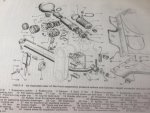Hi. Wondering if anyone can shed light on the mysterious "nut for eccentric pin operating corrector" that sits halfway up the fork thats attached to the front anti-roll bar (sway bar) in which the front height corrector ball sits. Let me explain...
Have changed out a sticky height corrector. At same time adjusted the suspension link heights which were both at 197mm so have set those to 198/199mm as per the book. Also reseated the roll bar shims and replaced the bent self-levelling headlight wire. All good so far.
Bled the system and the back came up but the front didnt. Cause is that the height corrector hadnt got the signal from the roll bar which I presume is just resetting the height at the front. Applied a screwdriver to acivate the height corrector and everything working - just that the fork needs moving nearer the height corrector.
However the manual height corrector rod which goes through the fork is noticably catching so I'm thinking that the rod isnt sitting squarely in the middle of the hole in the fork. A look in the Autobooks 742 manual and there's a diagram showing this eccentric pin which is halfway up the fork. I cant make out if the fork is one piece attached to the roll bar or two pieces connected by the pin. No mention of this in other manuals Ive looked at.
Anyways, I loosened the nut and have tried turning the pin with a screwdriver in the slot in the pin but cannot for the life of me see what it is actually adjusting. I was hoping it might adjust the fork in relation to the rod.
Am I barking up the wrong tree? Any ideas what this eccentric pin does and now that I have adjusted it what I would expect to have screwed up!! Any idea how to sit the rod in the fork hole so it doesn't catch?
Thanks in hope. Pete
Have changed out a sticky height corrector. At same time adjusted the suspension link heights which were both at 197mm so have set those to 198/199mm as per the book. Also reseated the roll bar shims and replaced the bent self-levelling headlight wire. All good so far.
Bled the system and the back came up but the front didnt. Cause is that the height corrector hadnt got the signal from the roll bar which I presume is just resetting the height at the front. Applied a screwdriver to acivate the height corrector and everything working - just that the fork needs moving nearer the height corrector.
However the manual height corrector rod which goes through the fork is noticably catching so I'm thinking that the rod isnt sitting squarely in the middle of the hole in the fork. A look in the Autobooks 742 manual and there's a diagram showing this eccentric pin which is halfway up the fork. I cant make out if the fork is one piece attached to the roll bar or two pieces connected by the pin. No mention of this in other manuals Ive looked at.
Anyways, I loosened the nut and have tried turning the pin with a screwdriver in the slot in the pin but cannot for the life of me see what it is actually adjusting. I was hoping it might adjust the fork in relation to the rod.
Am I barking up the wrong tree? Any ideas what this eccentric pin does and now that I have adjusted it what I would expect to have screwed up!! Any idea how to sit the rod in the fork hole so it doesn't catch?
Thanks in hope. Pete

